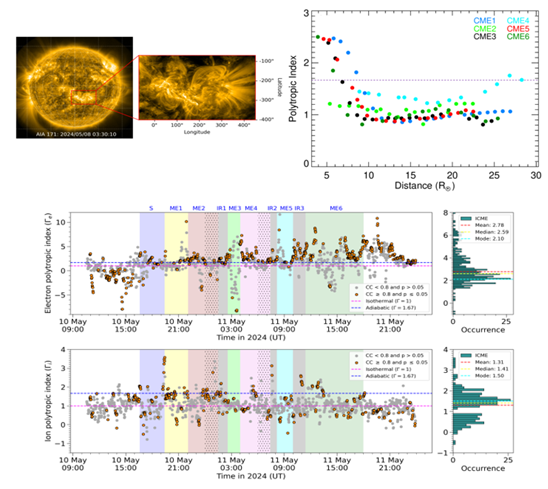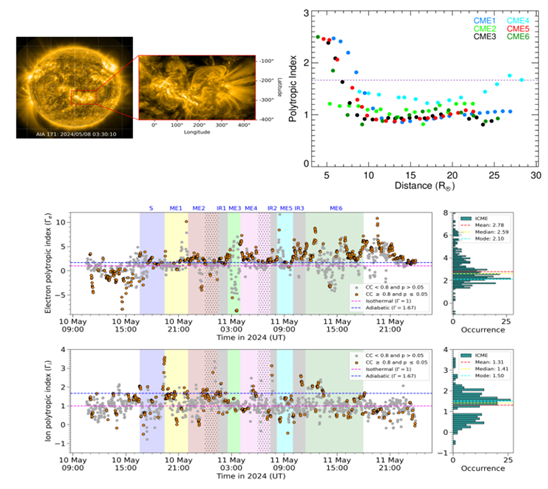Astronomers have unveiled the intricate tale behind a series of powerful solar eruptions called Coronal Mass Ejections (CMEs), that resulted in rare northern lights dancing across Ladakh’s night skies in May 2024, uncovering a solar storm unlike any seen in the past 20 years.
CMEs are massive ejections of magnetized plasma from the Sun’s corona. When such solar blasts are directed toward the Earth, they can cause geomagnetic storms capable of disrupting satellite operations, communication systems and power grids. The great geomagnetic storm that started on 10th May 2024 was linked to a rare sequence of six different CMEs erupting in succession, associated with both solar flares and filament eruptions from an interacting complex active region on the Sun.
Until now, gaining a complete understanding of how CMEs evolve thermodynamically as they travel from the Sun to Earth has remained challenging, primarily due to limited observations near the Sun as well as in near-Earth space.
To bridge this gap, a team of solar astrophysicists led by Dr. Wageesh Mishra, a faculty member at Indian Institute of Astrophysics (IIA) used observations from the NASA & ESA space missions. They built a model to investigate the manner in which the rare chain of six interacting solar blasts reported from IIA’s Indian Astronomical Observatory in Hanle, Ladakh, interacted with each other and evolved thermally en route from the Sun to Earth resulting in IIA’s.
The team traced not just the paths but the temperatures and magnetic states of these blasts as they expanded across the solar system. Surprisingly, they found that these solar clouds do not just carry heat—they change their thermal behaviour mid-journey. Initially, the CMEs release heat but then enter a state where they actually absorb and hold onto it.
At Earth’s doorstep, using data from the Wind spacecraft, Scientists found something even stranger. The final storm cloud had two intertwined magnetic structures—called “double flux ropes.” These acted like tangled magnetic braids, with compressed fields and odd patterns of heating and cooling between electrons and ions.

Fig: Top panel – The complex solar active region observed from SDO/AIA (left panel) on the Sun that gave rise to the sequence of CMEs responsible for the May 2024 geomagnetic storm and the FRIS model-derived polytropic indices of each CME (right panel) near the Sun. Bottom panels – Corresponding electron and proton polytropic indices measured from near-Earth observations, revealing distinct thermal states within the interacting CME structures. The thermal characteristics of different segments of the complex ejecta at 1 AU vary significantly, likely resulting from interactions between six successive CMEs.
“Using wide-field coronagraphic data and an analytical framework known as the Flux Rope Internal State (FRIS) model, we tracked the thermodynamic evolution of six CMEs and their mutual interactions in interplanetary space,” said Soumyaranjan Khuntia, the lead author and a doctoral scholar at IIA, an autonomous institute under the Department of Science and Technology (DST). The study revealed that most CMEs initially released heat but later transitioned into a state that gets heated instead, particularly to a near-constant temperature state as they expanded further from the Sun.
“Our analysis demonstrates that CME-CME interactions lead to significant thermal restructuring within. By the time they reach the Earth, the electrons in the complex ejecta were found to be in the heat-releasing state, while ions displayed a mix of heating and cooling behaviour, with the heating state being the dominant mode overall,” said Khuntia. “This study is the first of its kind, both in India and internationally, to capture the continuous thermodynamic evolution of multiple interacting CMEs across such a vast distance in the heliosphere,” said Dr. Mishra.
“This work marks an important step toward understanding the thermal signatures associated with the ability of CMEs and their evolving substructures to disturb Earth’s space environment. Our aim is to explore whether thermal properties can be used as precursors to forecast intense geomagnetic disturbances,” said Anjali Agarwal, co-author of the work and a doctoral scholar at IIA.
These findings published in the Astronomy and Astrophysics Journal.
offer a major step forward for improving space weather forecasting models, particularly in predicting the impact of complex CME events on Earth’s magnetosphere.
Wageesh Mishra added that his research team looks forward to incorporating observations from India’s Aditya-L1 space mission, including the Visible Emission Line Coronagraph (VELC), observations from spacecraft closer to the Sun, as well as near-Earth observations from the Aditya Solar wind Particle Experiment (ASPEX). These instruments will allow a complete Sun-to-Earth study of such CMEs.
Publication link: DOI: 10.1051/0004-6361/202452866
Arxiv link: https://arxiv.org/abs/2504.03335

























































